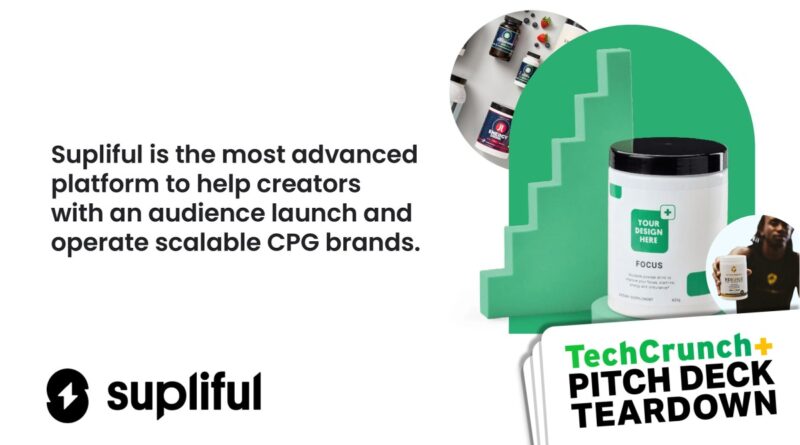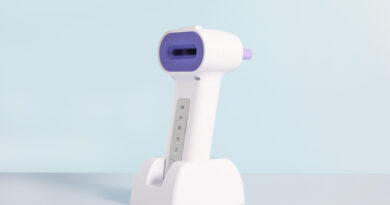Pitch Deck Teardown: The Perfect Pitch Deck
We are a good 47 pitch decks into our Pitch Deck Teardown series, and one piece of feedback we’ve gotten frequently is that it’s easy to be a critic: What would we have done?
Well, we’re not ones to turn away from a challenge here at TechCrunch+. So for this week’s pitch deck teardown, we’re going to try something different.
About six months ago, we went through a pitch deck by a company called Supliful. We celebrated the pitch deck for being very good, but we may have poked a little bit of fun at it for being riddled with spelling mistakes and other silliness. At its heart, though, the deck was good.
So for this week’s teardown, I buddied up with the team at Trulytell (with an assist from their designer, Jake Muller) to improve Supliful’s deck until it became the perfect pitch deck.
Okay, we didn’t quite get it 100% perfect. There are still some issues, and in this post, we will take them apart to learn what could be improved and how we’d do that.
We’re looking for more unique pitch decks to tear down, so if you want to submit your own, here’s how you can do that.
Slides in this deck
- Cover slide
- Traction slide
- Summary slide
- Problem slide
- What makes a great CPG brand slide
- Solution slide
- Product slide
- Case study slide
- Business model slide
- Market slide
- Predicate businesses slide
- Competitor slide
- Testimonial slide
- Team slide
- Ask slide
- Operating plan slide
- Closing slide
The first five slides
We’re going to do things differently this week: I’m going to break down every single slide in detail and explain why they work and what works about them. I’m also going to explain what could be improved upon or where investors may bring up hard questions.
So we will cover the first five slides here and we’ll stick the remaining 15 behind the paywall. Yes, you should absolutely subscribe to TechCrunch+: did I mention that we have nearly 50 sample pitch decks, complete with commentary, and an additional 30 to 40 articles breaking down every imaginable aspect of pitching and pitch decks?
If you’re a founder raising money, this is the most bang for your buck you’ll get. Go on, subscribe. It makes sense to.
With that out of the way, let’s do this!
Slide 1: Cover Slide
[Slide 1] H’okay, that’s a sweet earth you might say. Let’s go! Image Credit: Supliful / TechCrunch / Trulytell
The opening slide does a lot of heavy lifting to help investors identify if your startup is in-thesis. This one lays out a bunch of the core pieces of the business:
- It shows a summary of what the business is about (“the most advanced platform to help creators launch and run CPG brands”);
- It shows how much they’re raising ($1 million);
- It shows the goals of the fundraise (“grow to $13 million ARR at $2.4 million monthly GMV”);
- The photo illustrates what the company actually does: “Your design here,” along with an influencer; and
- Between the lines, you realize this is a B2B2C company, assuming that influencers and content creators are businesses.
What works about this slide: It clearly sets the pace for what’s to come. It imparts a lot of information that would enable an investor to get to a quick ‘no’ in case the round size, industry or overall business idea is unappealing to them.
What could be improved: This company is based in Riga, Latvia, which is in north-eastern Europe. That might “disqualify” it for a lot of investors who have location as part of their investment thesis. We decided not to include that on this slide and made sure to use slide 2 (traction) to show off what the company is currently doing. It’s a little sneaky, perhaps, but we figured we didn’t want to prejudice investors unduly — let’s get them excited about the company and its potential!
We could also have specified that this is a B2B2C company, but we figured an astute investor might figure that out given the info here.
We hope the graphic on this slide tells an important part of the story, but there may be better ways to illustrate Supliful’s core business model.
Finally, I spent some time considering if we should spell out what CPG (consumer packaged goods) stands for. But I figured if an investor needed to google CPG, there’s no way they would invest in this space, so I left it as the slightly obscure TLA it is.
Slide 2: Traction slide
![[Slide 2]](https://techcrunch.com/wp-content/uploads/2023/05/SupplifulPitchDeckTechCrunchPitchDeckTeardown-slide-0002.jpg)
[Slide 2] Up and to the right. Image Credit: Supliful / TechCrunch / Trulytell
What do you do when you have a company that has a few challenges with fundraising but a ton of promising traction?
My take is always: If you have revenue, it means you’ve proven you can pull off the hardest part of building a startup. It almost doesn’t matter what else is wrong in the business, if you are making sales, you’re on to something. Once you have traction, the question becomes how much it costs to acquire new customers, what those customers are worth, and how big the market is.
Opening with a traction slide requires you to explain what the traction represents. This slide looks pretty simple, but it conveys a lot of data: Sharp growth, some cumulative figures and some lovely indications of a company on a steep growth trajectory.
What works about this slide: There was a dip in revenue, but it turns out the company had a great reason for that: It had to throw a merchant off the site for being dishonest. The dip in revenue is bad, but highlighting it with the arrow and an explanation goes a long way towards ameliorating concerns. The revenue dipped the month before, too, which isn’t addressed, but the graph shows explosive growth in the six months since then.
In addition, I like how this graph shows revenues and not gross merchandise value (GMV). It would have been easy to ‘pump’ the numbers by quoting GMV here, but the founders (and sophisticated investors) know that metric holds little meaning.
What could be improved: It could be argued that some of these metrics are vanity metrics. Cumulative gross revenue is a tricky one: Yes it’s important, but the growth curve is so steep that it shows a skewed picture that’s actually not in the company’s favor.
The “33% of orders are by subscribed customers” figure could do with some explaining, but you have the opportunity to talk about how subscribed customers lead to recurring revenues with a voice-over.
Slide 3: Summary slide
![[Slide 3]](https://techcrunch.com/wp-content/uploads/2023/05/SupplifulPitchDeckTechCrunchPitchDeckTeardown-slide-0003.jpg)
[Slide 3] In summary… Image Credit: Supliful / TechCrunch / Trulytell
I love starting with a summary slide early in the deck to set the pace. Here, we are closing our introductory three-slide arc. It summarizes the value proposition to a creator (“it takes 15 minutes”), reminds investors that this company has real traction (average 30% growth month-on-month), highlights the early indicators of product-market fit, and summarizes the product and market space by saying, “Having branded products is a huge opportunity.”
What works about this slide: Honestly, I would probably exclude this slide from a send-ahead deck and just copy and paste the mission and the four bullet points into an email to get a would-be investor to open the deck. But I love showing off, clearly and simply, why someone would want to keep reading and invest their $1 million.
What could be improved: There’s a damn typo on the slide! The cover slide and the financials show that the company is raising $1 million, but this one says $2 million.
As we were working through the operating plan (second-last slide), we decided that the financials were looking good enough that we only needed to raise $1 million and we changed it, but we forgot to change it here. Would it have been easy to go back and fix that and re-export the slide? Yes, but I want to illustrate that mistakes do happen, even when you have a lot of smart people trying to make the ‘perfect’ pitch deck.
Slide 4: Problem slide
![[Slide 4]](https://techcrunch.com/wp-content/uploads/2023/05/SupplifulPitchDeckTechCrunchPitchDeckTeardown-slide-0004.jpg)
[Slide 4] So what’s the problem? Image Credit: Supliful / TechCrunch / Trulytell
Every company needs a problem statement. Here, Supliful explains that this market already exists but is unavailable to lower- and middle-tier content creators and influencers.
Creating a consumer packaged goods brand is possible — you can white-label or formulate your own — but bringing a new product to market, then branding, manufacturing and dealing with the logistics of shipping it can be an expensive and time-consuming nightmare.
That’s the problem Supliful addresses, and the fear it alleviates is beautifully outlined at the bottom of the slide: What if I spend $25,000 and a year of my life to create something that won’t be worth the while?
What works about this slide: Selling by way of alleviating a fear works really well. I like that the problem statement is concise (“time-intensive and costly”) and it gives us specific reasons why the process is difficult. Simple, clean and easy to understand.
What could be improved: A lot of investors have been bitten by companies trying to market to “influencers.” It’s a very amorphous demographic that’s relatively hard to market to. My worry here is whether, upon reading this slide, an investor might go, “So what?”
Another, more important problem I have is the potential environmental impact angle: “Do we really need more brands selling stuff?” But I suppose if that’s at the forefront of an investor’s mind, no amount of pitching will get them to change their mind.
Slide 5: What makes a great CPG brand
![[Slide 5]](https://techcrunch.com/wp-content/uploads/2023/05/SupplifulPitchDeckTechCrunchPitchDeckTeardown-slide-0005.jpg)
[Slide 5] So, er, what? Image Credit: Supliful / TechCrunch / Trulytell
This slide is a little bit of a curveball because you rarely have to explain what a market is in order to explain your company.
However, the point here is that Supliful solves a really specific problem at the intersection of two industries: Taking care of the product manufacturing, branding and manufacturing is one industry, and taking care of billing, logistics and the rest of the operations stack is another. The companies on the left are well-known, successful brands in the former industry, and the ones on the right are successful logistics companies.
It’s an unusual slide to have on a pitch deck, but I love it for this “perfect pitch deck” because it illustrates clearly that you are not limited to the 15-16 slides that are typically recommended. If you need a slide or two to tell a part of the story that is specific to your company, industry or market, then go for it. Just ensure that you have a deep understanding of why you are including it.
In my pitch coaching practice, I often have to ask my clients, “What are you trying to convey here?” and “Is there a way to tell this story on one of the ‘standard’ slides?” If you have a clear answer for the first question and respond to the second one with a resounding ‘no,’ chances are that you’ll have to get a bit creative with a less-standard slide.
One warning, though: If you find yourself having four or five non-standard slides, something is probably off with the overall narrative or you’re getting too deep into the weeds.
What works about this slide: This slide plants the seed for some truly huge opportunities. The 3PL (third-party logistics) brands on the right are very successful businesses, and building on their huge followings, the brands on the left are interesting market-challengers to keep an eye on. Supliful is attempting to convey that it is the ‘right’ company to unlock these business models.
What could be improved: I suspect this story could be told without this slide, but I wanted to keep it in so I could use it as an example.
In the rest of this article, we’ll take our proverbial X-ray machine to the next 15 slides of this deck.
Pitch Deck Teardown: The Perfect Pitch Deck by Haje Jan Kamps originally published on TechCrunch





